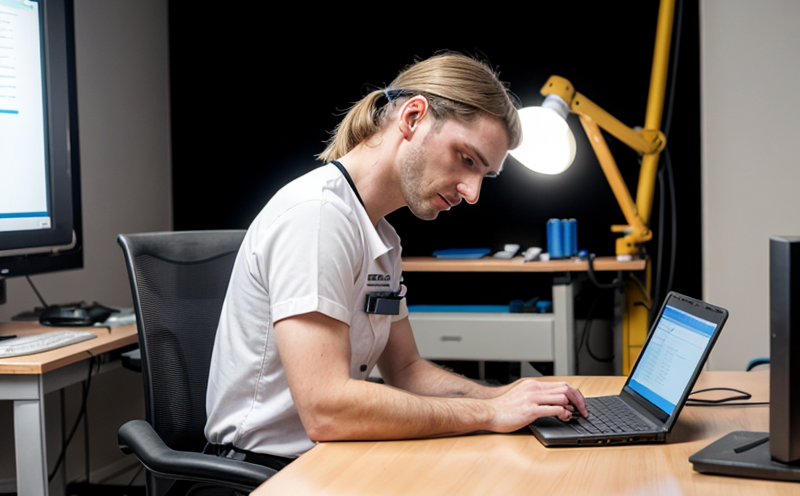ISO 11226 Working Posture Ergonomic Testing
The ISO 11226 standard is pivotal in the aerospace and aviation sector, ensuring that working postures are optimized for human factors and ergonomics. This standard plays a crucial role in enhancing safety, reducing fatigue, and improving productivity among personnel who spend extended periods in specific positions or movements. Aerospace and aviation industries face unique challenges due to the high stress environments and critical tasks performed by their employees.
The primary objective of ISO 11226 is to provide guidelines on how to measure and evaluate human working postures that can affect job performance, health, and safety in various ergonomic conditions. This testing ensures compliance with international standards, which are essential for maintaining a safe and efficient workspace. The standard emphasizes the importance of ergonomics in preventing musculoskeletal disorders (MSDs) and other occupational injuries.
The working postures evaluated under this standard include seated, standing, and mixed postures that can be encountered during tasks such as cockpit operations, manufacturing processes, maintenance activities, and more. Aerospace and aviation personnel often perform repetitive movements or maintain static positions for extended periods, making ergonomic assessments critical to their health and safety.
The testing process involves detailed observation of the working environment, including the layout of equipment, tools, and workspace design. The aim is to identify potential risks that can lead to discomfort or injury. This includes evaluating the height of workstations, visibility, reach distances, and the overall ergonomic design of the workspace. By adhering to ISO 11226, industries can ensure that their environments are optimized for human factors, thereby enhancing productivity and reducing the risk of occupational injuries.
In addition to physical assessments, psychological evaluations may also be conducted to understand the mental demands placed on personnel. This is particularly important in high-stress environments like cockpit operations or emergency response scenarios. The standard provides a framework for assessing these parameters, ensuring that workers are not only physically comfortable but also mentally prepared for their tasks.
Once the working postures have been evaluated, detailed reports are generated to outline any areas of concern and provide recommendations for improvement. These reports serve as a valuable tool for quality managers, compliance officers, R&D engineers, and procurement teams in making informed decisions about workspace design, equipment selection, and personnel training.
The ISO 11226 standard is widely recognized across the aerospace and aviation sectors for its comprehensive approach to ergonomic testing. By incorporating this standard into their operations, organizations can ensure that they are meeting international best practices and enhancing the overall safety and efficiency of their workforce.
Applied Standards
| Standard | Description |
|---|---|
| ISO 11226:2014 | Ergonomic design of workstations – Evaluation and control of working posture stress in office and other seated tasks. |
| IEC TC 159 Ergonomics for Workplaces and Working Postures | International Electrotechnical Commission technical committee focusing on ergonomic aspects related to workplaces and working postures. |
| ASTM E2674-08(2013) | American Society for Testing and Materials standard for the assessment of workstations using human factors engineering methods. |
Scope and Methodology
The scope of ISO 11226 Working Posture Ergonomic Testing encompasses the evaluation of working postures to ensure they are safe, comfortable, and conducive to optimal performance. The methodology involves a multi-faceted approach that includes physical assessments, psychological evaluations, and the use of advanced instrumentation.
Physical assessments typically involve detailed observations of the work environment, including workstation design, layout, and equipment arrangement. This is done to identify any potential ergonomic risks such as awkward postures or excessive strain on muscles and joints. The testing process also involves measuring various parameters such as chair height, desk clearance, and overall workspace ergonomics.
Psychological evaluations are conducted to understand the mental demands placed on personnel. These assessments help in identifying stressors that may impact job performance and safety. This includes evaluating factors like workload, task complexity, and the presence of distractions or interruptions. Psychological evaluations play a crucial role in ensuring that working conditions do not lead to burnout or other psychological issues.
The use of advanced instrumentation is an integral part of ISO 11226 testing. This can include motion capture systems, force sensors, and other devices designed to measure physical stress and strain on the body. These instruments provide precise data that can be used to make informed decisions about workspace design and equipment selection.
Once the assessments are complete, detailed reports are generated. These reports outline any areas of concern identified during testing and provide recommendations for improvement. The reports serve as a valuable tool for quality managers, compliance officers, R&D engineers, and procurement teams in making informed decisions about workspace design, equipment selection, and personnel training.
The methodology employed under ISO 11226 ensures that working postures are evaluated comprehensively, taking into account both physical and psychological factors. This approach helps to create a safer, more comfortable, and efficient work environment for personnel in the aerospace and aviation sectors.
Eurolab Advantages
At Eurolab, we pride ourselves on delivering high-quality ISO 11226 Working Posture Ergonomic Testing services that meet the highest international standards. Our experienced team of professionals ensures that your workplace is evaluated thoroughly and comprehensively, providing you with actionable insights to enhance safety and productivity.
We offer a range of services tailored to meet your specific needs, including:
- Comprehensive ergonomic assessments
- Advanced instrumentation for precise data collection
- Detailed reporting and recommendations
- Expert guidance on best practices in workspace design
- Ongoing support and training for personnel
Our team of experts is dedicated to ensuring that your workplace meets the highest ergonomic standards, providing a safer and more comfortable environment for all personnel. With Eurolab, you can trust that your ISO 11226 Working Posture Ergonomic Testing will be conducted with precision and accuracy.





